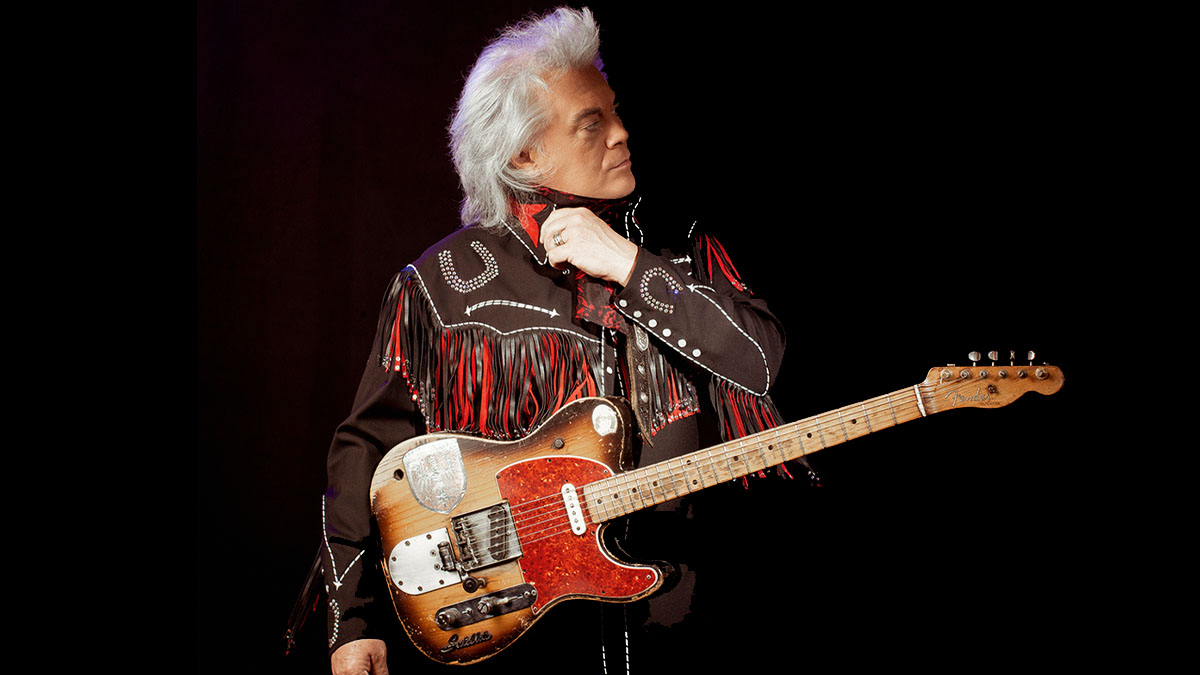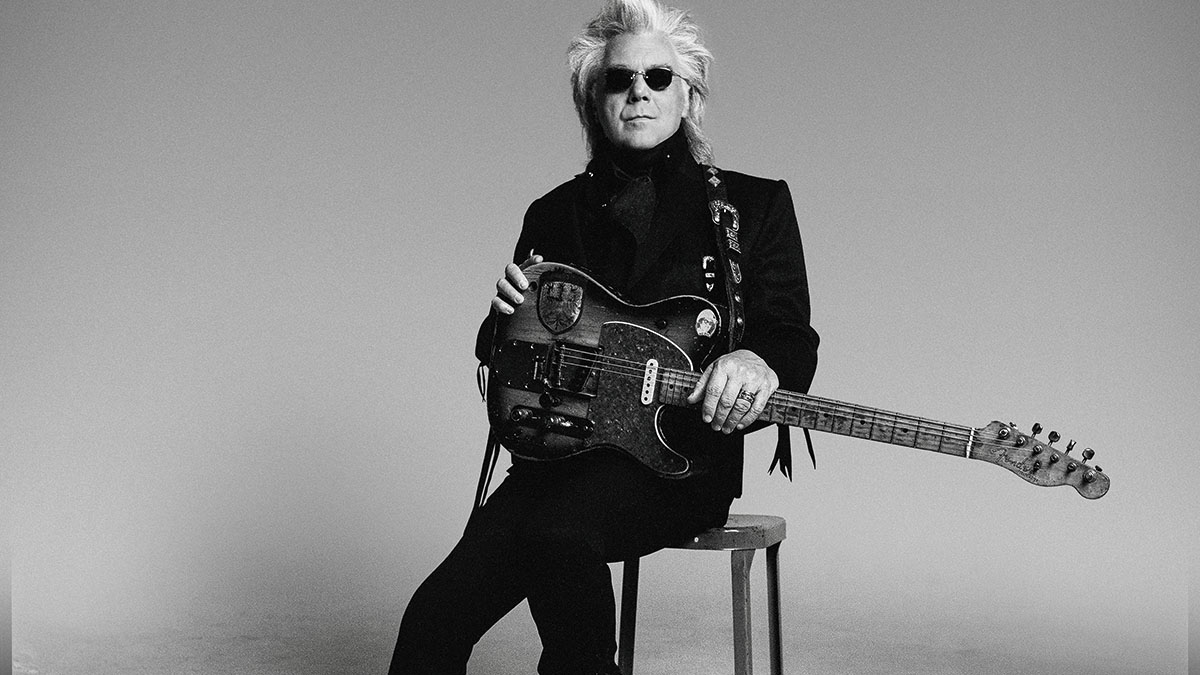Marty Stuart: “I appreciate the Stratocaster, but I really can’t do it justice. It’s two different planets, two different universes – and I’m a Tele guy”
Telecaster master Marty Stuart recounts a half-century love affair with the snub-nosed Fender model, from falling for the twang and surviving the honky-tonks, to the spookiest session with his iconic ‘Clarence’ Tele and snapping up Mick Ronson’s ’52 Esquire

It’s not easy to upstage Marty Stuart. Since 1989, when the Mississippi bandleader signed his star-making deal with MCA and set out to “put the image back into country”, he’s walked the boards in scarves, rhinestones and hand-stitched bolero jackets, with that get-up topped off in later years by a shock of silver hair that makes him resemble an avuncular werewolf.
“When you come out dressed up like Porter Wagoner and call your band the Fabulous Superlatives,” he drawls, “you better be able to do something.”
Of course, the main event at a Stuart show is the bob and weave of the man’s picking, which drove him to commercial peaks on 1989’s Hillbilly Rock, 1991’s Tempted and 1992’s This One’s Gonna Hurt You (all gold-sellers), and often thrills on this year’s Altitude.
But for all his skill and showmanship, you might find your eye wandering to the so-called ‘Clarence’ Telecaster that has spent four decades vying with Keith Richards’ Micawber and Bruce Springsteen’s Mutt as the most storied snub-nosed Fender in history.
To take you right back to the start, how did you first fall for the Fender Telecaster?
“It was from Luther Perkins’ playing. And to this day, my favourite record of all time is Johnny Cash At Folsom Prison. Luther Perkins was my original guitar hero. Closely followed by Don Rich from The Buckaroos. And he was closely followed by Roy Nichols with The Strangers. These were the guys that I looked at when I was just a kid down in Mississippi learning to play guitar. I hoped to one day own a Telecaster, but I couldn’t believe it when I finally got one. And it’s still the guitar of my dreams.”
What was the very first Tele you ever owned?
Get The Pick Newsletter
All the latest guitar news, interviews, lessons, reviews, deals and more, direct to your inbox!
“It was a ’73 or ’74 blonde Tele. I was trying to learn how to play like Clarence White from The Byrds. So I took that guitar down to Sho-Bud Steel Guitar Company in Nashville and Shot Jackson, the owner, he put a B-string bender in it for me. I wanted it to look like and sound like Clarence’s guitar. So that was the first Tele I had. I really didn’t know how to work the B-Bender, but it got me started. I don’t have it any more. There’s a kid in Arkansas who bought that guitar.”
What is it about the feel and sound of a Tele that works for you?
“It just fits. Sometimes you get in a car and say, ‘This is my car.’ Or put on a coat and say, ‘That’s my coat.’ The Telecaster, it just fits my hands. It fits around my neck right. It doesn’t bother me that it’s got no top cutaway or third pickup.
“I mean, one of my favourite guitars I have is a 1952 Esquire – it was owned by Mick Ronson – and that only has one pickup. That’s all it needs because it’s just a great guitar. Y’know, I appreciate the Stratocaster, but I really can’t do it justice. I love the sound of both those guitars, but it’s two different planets, two different universes – and I’m a Tele guy.”

‘Twang’ is the term most often associated with the Telecaster. Was that an attractive quality for you?
“Yeah, the twang. Of course. I mean, if you listen to the solo from Workin’ Man Blues by James Burton, I don’t care who you are and how close you think you can play that solo – you’re not playin’ it. I’d argue that they could not have done that song exactly that way even one more time. It was one of those things that happened, and then it left the room.
“But there’s the Telecaster twang – and then there’s that California cool. There’s the outer edge of California cool that wraps around the twang. Clarence White had that. Roy Nichols had it. James Burton had it in spades. That whole cluster of California guys, they could make their Teles twang, but they also knew how to put palm trees and Sunset Boulevard and cool cars around them. Which made it just ultra cool. When you get to the West Coast, they just seem to let it fly out there.”
Why do you think the country scene fell in love with the Telecaster?
“Well, I think Buck Owens said it best. He said, ‘In the honky-tonks, we needed something that was louder than the crowds.’ And then, like Keith Richards once said, sometimes you needed a weapon. Isn’t there even a piece of footage of Keith whacking a guy with his guitar on stage? Telecasters made good weapons, too.”
I remember there was a redneck honky-tonk in Mississippi and there were two Doberman Pinschers on short leashes, with crazy guys with crazy looks in their eyes, just daring anyone to try something
Did you ever have cause to test that theory? There are some hair-raising stories about honky-tonks that put up chickenwire back in the day to protect the bands from flying bottles…
“I think that was a reality. I never experienced that. I remember there was a redneck honky-tonk in Mississippi and there were two Doberman Pinschers on short leashes, with crazy guys with crazy looks in their eyes, just daring anyone to try something. That was a little weird. There was a place in Waco, Texas, that was really rough.
“I don’t remember chickenwire myself, but I know it’s an absolute fact that some of those juke-joints had that stuff. We’re in theatres and nice halls these days – but I wouldn’t take anything from that rough and rowdy honky-tonk experience. It was an absolutely informative period of my life.”
You bought Clarence White’s famous Telecaster in 1980, paying his widow $1,450 [Stuart wanted to pay more]. What was its first outing?
“I was in Johnny Cash’s band at the time, and the first appearance that Tele made was when we did Saturday Night Live. I have no idea what the song was, and a B-string bender in the Johnny Cash band was useless because it didn’t fit his style – but that guitar was back out there amongst the world.”
I believe Clarence was originally a ’54, but [White’s Byrds bandmate] Gene Parsons did a lot of work on it, even crafted a lot of the parts himself
The guitar’s quirks are legendary. A body twice standard thickness, a proto B-Bender, Scruggs banjo tuners, a neck single coil from a Strat, a bridge pickup rewound by noted steel player Red Rhodes…
“Yeah. I believe it was originally a ’54, but [White’s Byrds bandmate] Gene Parsons did a lot of work on it, even crafted a lot of the parts himself. The back cap is like plyboard, and there’s parts of a Fender steel guitar in there. The B-string mechanism has a longer pull than most people have, and I think that alone makes me play it differently.
“The only things I’ve changed on that guitar since I got it – Ralph Mooney put a kind of palm-pedal on where it lowers the high E a half-step. I moved one of the Scruggs banjo pegs from the fifth to the sixth string. And routed out the back because when I first got the guitar, if you broke a string, you had to take that whole back off.”
Aside from that, you’ve stayed hands off?
“Yeah, other than that, it’s the same dirt that was on that guitar the day I touched it for the first time. There’s still that ‘Nudie the Rodeo Tailor’ sticker that Phil Kaufman originally put on there. It says ‘Satellite’ down low on the body, which is off of the dashboard of a Plymouth Satellite car. And the one that’s fading is a flag from Germany.”
You can put a thousand Telecasters around Clarence and they’re all probably wonderful, but that guitar, in my heart, it just speaks different.
What makes the Clarence Tele such a good recording guitar?
“It’s a ‘good at everything’ guitar. There are just certain guitars where the checklist is full. That guitar has a thousand different personalities. It is totally unique in each of those personalities. You can put a thousand Telecasters around it and they’re all probably wonderful, but that guitar, in my heart, it just speaks different.
“It just has a different voice. It also has a great legacy. I can only imagine where Clarence would have taken it, had he lived. He’s like Jimi Hendrix – he was just getting started. There is no telling. If I think too hard about the legacy of that guitar, I’ll fall down. I just have to keep moving forward and play.”
Keith Richards once said that you get the best from a Fender guitar by pairing it with a Fender amp. Given that you’re running the Clarence through a ’70s silver-panel Deluxe, would you agree with that?
“100 per cent. I’ve found Fender guitars and Fender amps a good combination. The ‘Silverface’ Deluxe, that tends to be where that guitar’s voice sings. It all depends on what you’re looking for.
“But the sounds that I love tend to be those West Coast ’60s kinda country guitar styles, like James Burton and Clarence, Ralph Mooney’s steel guitar tone, Roy Nichols’ guitar tone, Jimmy Bryant’s guitar tone. Those kind of players, they were bitey, they had muscle. That’s what drew my ear to that kind of sound.”
I've found Fender guitars and Fender amps a good combination. The ‘Silverface’ Deluxe, that tends to be where that guitar’s voice sings
What are the other great Telecasters in your collection?
“There’s that 1952 Esquire owned by Mick Ronson. That is probably one of the greatest Esquires in the world. There’s a song that I recorded back in the “90s called High On A Mountain Top – I think it was actually Richard Bennett who played the part on that guitar, on my record.
“But that guitar growls – it’s like a tiger. It’s wonderful. And then there’s a 1970 Rosewood Tele that Pops Staples played that Mavis and Yvonne [Staples] gave me. And that’s the one that Pops plays on The Last Waltz film. So that one comes to mind.”
What have been your most memorable sessions with Clarence?
“Well, I’ll give you this. There was a Byrds record called Byrdmaniax [1971]. Do you remember it? The album sleeve had the silver masks, right? I think they call them death masks. They’d plaster casted all the guys’ faces and painted them silver. One day in 2017, Clarence White’s daughter Michelle called me and said, ‘I want you to have the mask of my dad from the Byrdmaniax cover.’ I went, ‘Well, I’d be honoured.’ So she came by the studio and it was in a shadow box.
“I just laid it on the floor next to me in the studio. We were making my Way Out West record at the time and there was this song called Whole Lotta Highway (With A Million Miles To Go). I was trying to play this really straight-ahead Clarence White kinda solo on the B-Bender. And I look down and there’s Clarence looking up at me from the floor. That was probably one of the more memorable moments I’ve ever shared with that guitar. But it worked because it turned out to be a pretty good solo!”
Clarence is such a historically significant instrument – aren’t you ever afraid to hit it hard?
“Nah. It can take it. That’s what Telecasters were born to do!”
- Altitude is out May 19 and is available to pre-order now.
Henry Yates is a freelance journalist who has written about music for titles including The Guardian, Telegraph, NME, Classic Rock, Guitarist, Total Guitar and Metal Hammer. He is the author of Walter Trout's official biography, Rescued From Reality, a talking head on Times Radio and an interviewer who has spoken to Brian May, Jimmy Page, Ozzy Osbourne, Ronnie Wood, Dave Grohl and many more. As a guitarist with three decades' experience, he mostly plays a Fender Telecaster and Gibson Les Paul.
“What blew me away was that everyone wanted the curly maple top. People were calling, saying, ‘I’ve got to have the bird inlays’”: Paul Reed Smith on raising the Standard 24, finally cracking the noise-free guitar and why John Sykes is a tone hero
“It combines unique aesthetics with modern playability and impressive tone, creating a Firebird unlike any I’ve had the pleasure of playing before”: Gibson Firebird Platypus review





![[from left] George Harrison with his Gretsch Country Gentleman, Norman Harris of Norman's Rare Guitars holds a gold-top Les Paul, John Fogerty with his legendary 1969 Rickenbacker](https://cdn.mos.cms.futurecdn.net/TuH3nuhn9etqjdn5sy4ntW.jpg)





